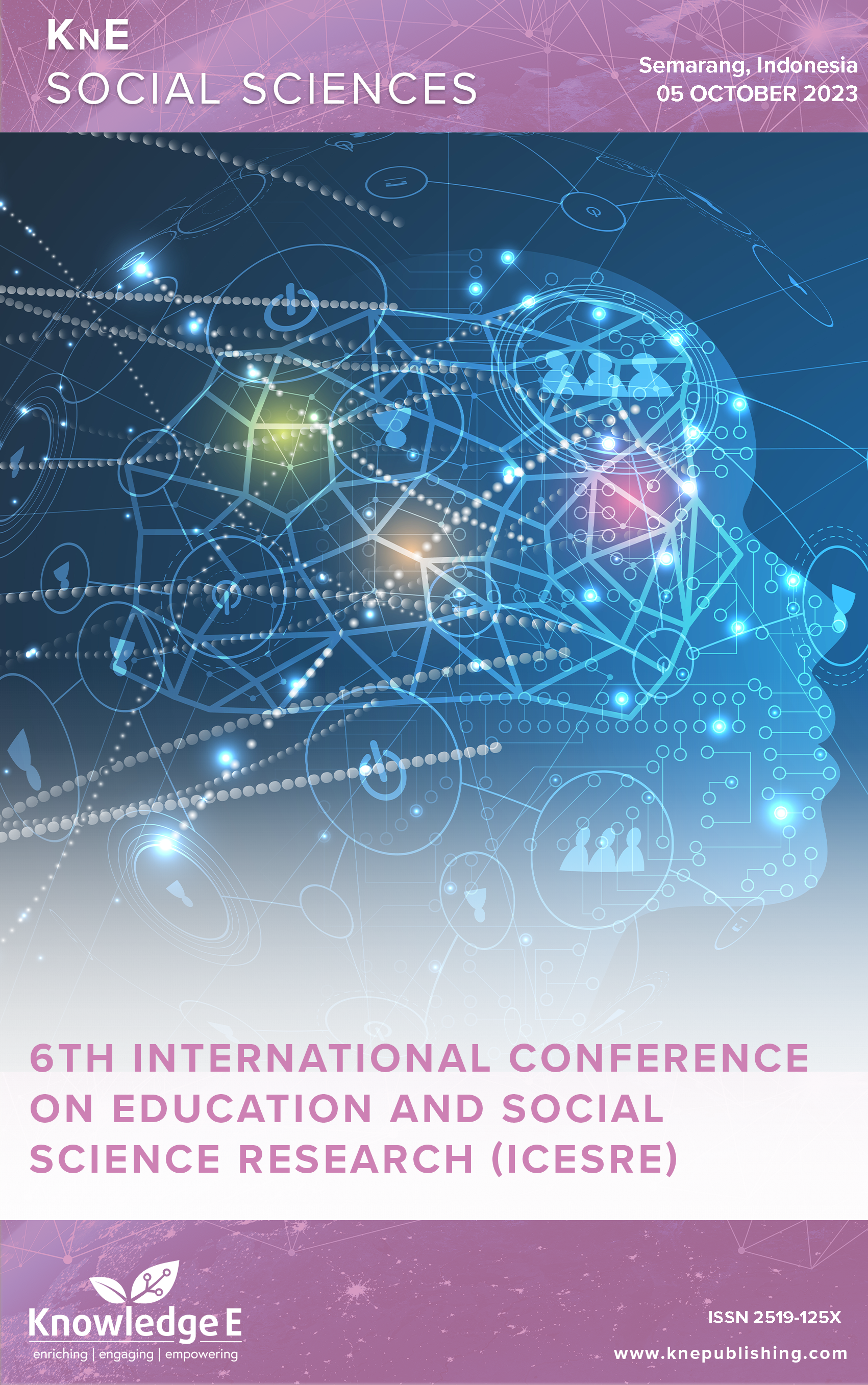Literacy Profile of Flood and Rob Disaster Mitigation Among Sciences Teachers in Central Java
DOI:
https://doi.org/10.18502/kss.v9i6.15312Abstract
There is a need to acquire the data description of science teachers regarding literacy mitigation in Central Java. However, there is no specific data that informs these conditions. Therefore, the research aims to identify the literacy of flood disaster mitigation among science teachers in the Central Java province. Several 125 science teachers from 6 districts/cities in Central Java were involved as respondents. The flood and tidal disaster literacy instrument consists of 17 items divided into 2 parts. The first part concerns the teacher’s knowledge of floods and tidal waves. The second part contains the teacher’s insights about mitigating flood and tidal disasters. The findings show that the average teacher’s knowledge about floods and tidal waves is good (8.4 of 10). Meanwhile, the average knowledge of science teachers regarding literacy of flood and tidal disaster mitigation is in the sufficient category (11.4 of 18). This fact shows that science teachers’ flood and disaster mitigation literacy needs to be improved. Instilling disaster mitigation literacy, especially floods and tidal waves, can be done by implementing disaster mitigation education in science learning through research and community service.
Keywords: mitigation literacy, disaster mitigation, STEAM, early warning system
References
Sahni P. Disaster mitigation: experiences and reflections. Prentice-Hall of India; 2001.
Nursyabani N, Putera RE, Kusdarini K. Disaster mitigation in increasing awareness of the threat of earthquakes at Andalas University. Journal of State Administration Science ASIAN (Association of State Administration Scientists), 2020, 8(2), 81-90. https://doi.org/10.47828/jianaasian.v8i2.12 DOI: https://doi.org/10.47828/jianaasian.v8i2.12
Pahleviannur MR. Disaster awareness education through disaster outreach as an effort to increase students’ knowledge of disaster mitigation. Journal of Social Science Education, 2019, 29(1), 49-55;https://doi.org/10.23917/jpis.v29i1.8203 DOI: https://doi.org/10.23917/jpis.v29i1.8203
Rahman AZ. Study of landslide disaster mitigation in Banjarnegara Regency. Gema Publica: Journal of Management and Public Policy, 2015, 1(1), 1- 14;https://doi.org/10.14710/gp.1.1.2015.1-14 DOI: https://doi.org/10.14710/gp.1.1.2015.1-14
Al-Maraghi FA, Rochman C, Suhendi HY. Literacy profile of students regarding volcanic disaster mitigation in the Sukaratu Tasikmalaya area. WaPFi (Physics Education Forum), 2017, 2(2), 32-35.;https://ejournal.upi.edu/index.php/index/index DOI: https://doi.org/10.17509/wapfi.v2i2.8275
Zakwandi R, Rochman C, Nasrudin D, et al. Physics literacy profile of madrasah students towards mitigation of the Sinamar trunk erosion disaster. BELAJEA: Journal of Islamic Education, 2018, 3(1), 47-58. http://dx.doi.org/10.29240/bjpi.v3i1.279 DOI: https://doi.org/10.29240/bjpi.v3i1.279
Rofiah NH, Kawai N, Nur Hayati E. Key elements of disaster mitigation education in inclusive school settings in the Indonesian context. Jàmbá: Journal of Disaster Risk Studies, 2021, 13;1159. http://dx.doi.org/10.4102/jamba.v13i1.1159 DOI: https://doi.org/10.4102/jamba.v13i1.1159
Salawane C, Supriyadi S, Rusilowati, etal. Teaching Materials using SETS Approach for Volcanic Dust Disaster Mitigation.Journal of Physics Education Research & Development. 2020, 6(2), 195-202 ; https://doi.org/10.21009/1.06206 DOI: https://doi.org/10.21009/1.06206
Supriyadi, Rusilowati A, Linuwih S, Binadja A, Salawane C. Science environment technology and society approach learning to improve natural disaster mitigation literacy. Journal of Physics: Conference Series,2019,1387;https://iopscience.iop.org/article/10.1088/1742- 6596/1387/1/012119/meta DOI: https://doi.org/10.1088/1742-6596/1387/1/012119
Suharini E, Baharsyah M. Learning about landslide disaster mitigation based on a role-playing method assisted by the disaster education pocketbook. Review of International Geographical Education Online, 10(4), 2020., 618- 638;https://dergipark.org.tr/tr/pub/rigeo/issue/59150/767474 DOI: https://doi.org/10.33403/rigeo.767474
Mahmudah S, Fauzia F. Application of a Simulation Model on Earthquake Natural Disaster Mitigation Learning Based on Animation Videos to Improve Student Learning Outcomes. Basicedu Journal Vol, 6(1);https://jbasic.org/index.php/basicedu
Juhadi, Hamid N, Trihatmoko E, Herlina M, Aroyandini EN. Developing a Model for Disaster Education to Improve Students’ Disaster Mitigation Literacy. Journal of Disaster Research. 2021 16(8), 1243-1256. https://doi.org/10.20965/jdr.2021.p1243 DOI: https://doi.org/10.20965/jdr.2021.p1243
Brown LM, Haun JN, Peterson LJ. A Proposed Disaster Literacy Model.Disaster Medicine and Public Health Preparedness,2014,8, 267 – 275. https://doi.org/10.1017/dmp.2014.43 DOI: https://doi.org/10.1017/dmp.2014.43
Prihadi S. Strengthening 21st Century Skills through Flood Disaster Mitigation Learning (Case Study: Non-Formal Learning for Children of Bantaran BengawanSolo in Nusupan Village). In Proceedings of the 2017 FKIP UMP National Geography Education Seminar.
Khasanah K, Sari SN, Slamet S, Prihandoko TL. Strengthening PAUD Teachers on Disaster Mitigation in Preparing for Natural Disaster Themes for Students in Demak Regency. Manggali, 2023, 3(1), 164-171. DOI: https://doi.org/10.31331/manggali.v3i1.2509
Kawasaki H, Yamasaki S, Kurokawa M, Tamura H, Sonai K. Relationship between Teachers’ Awareness of Disaster Prevention and Concerns about Disaster Preparedness. Sustainability, 2022, 14(13), 8211 https://doi.org/10.3390/su14138211 DOI: https://doi.org/10.3390/su14138211
Napere JR, RD, Canencia OP. Exploring the disaster management of teachers and pupils in Iligan City, Philippines. IAMURE International Journal of Ecology and Conservation, 2013. 8, 147.https://www.ejournals.ph/article.php?id=3013 DOI: https://doi.org/10.7718/ijec.v8i1.749
Sugiyono S. Metode penelitian kombinasi (mix methods). Bandung: Alfabeta; 2015.

